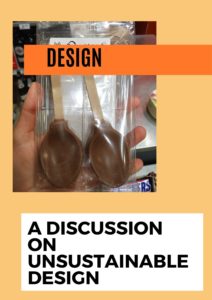
A discussion on unsustinable design.
“But, all the packaging it carries for just two servings of hot chocolate is disproportionate!”
One of the places I find the most unsustainably designed products is the supermarket. The way food makes its way to our table is being improved— we’re glad to be part of this process and conversation.
Spotting unsustainable designs
Here is a product that caught my attention (image in heading). I had seen it a few times at a local branch of a big chain supermarket. You might not know it by looking at it straight away; it is a clever way of delivering two servings of hot chocolate.
The product itself is not problematic. It’s a popsicle stick with chocolate molded into a spoon shape attached to it, which If sourced ethically and sustainably, is not bad at all. But, all the packaging it carries for just two servings of hot chocolate is disproportionate.
It comes with a 15 cm ×10 cm rather thick plastic tray as well as a plastic bag. It also has 2 laminated stickers; one with the logo and the other with info on how to use this product and its nutrition facts. The bag is then sealed with an adhesive.
Rethinking The Packaging
With such a competitive market, displaying our products for customers to recognize, understand their function and value can be very challenging. This is the possible reasoning as to why the hot chocolate spoon is so heavily displayed in plastic.
How could this brand improve their unsustainable packaging design into a more circular/sustainable/even regenerative option?
- Going package free, with a bring your own package/refill model.
- Perhaps using material that is more readily recyclable for the packaging could be an option as you may know very little plastic is actually recycled.
- Creating a new material that uses byproducts from the production of the hot chocolate to use as packaging (circular input).
- Maybe keeping the product completely concealed in a recycled paper envelope and using print to illustrate how this product is used is another? (not ideal)
- Exploring their options with new materials that are sustainably sourced & produced and that will easily biodegrade into non-toxic material or can be composted, of course if and when the composting facilities are available.
My Current Conclusion
For many companies, plastic remains the safest way to deliver food at low cost, this is obviously arguable when you consider that plastic leaches chemicals into food and beverages, and the immense cost of waste management that it incurs. Perhaps it would be practical to reserve plastic use for essential products in bulk until we can establish the widespread use of positive impact, low cost, food safe packaging alternatives. This can be a quick and direct way to keep prioritizing food safety and food availability while cutting down on waste. Following a similar process to what we did during COVID, a ban.
Is it feasible for supermarkets to place this kind of limitation on suppliers?
How about you? Where do you see unsustainable designs? Where do you see room for improvement?
I invite you to take a photo of the most unsustainable product or service you have seen in a while and tell us how you would make it better. Send it to us and we will share our favorite picks.

About the Author: Lara Mehanna
I’m a circularity and regenerative business consultant, trainer, and instructional designer. I work with SMEs on designing out waste and improving business experience. My story with sustainability started between kitchens and local farms over 10 years ago. I have had the privilege of establishing and assisting with the development of many green businesses in the areas of product design, arts, farming, and hospitality. You will find many more of these examples and applications in my courses and training programs.

Thanks for your blog, nice to read. Do not stop.
Thank you for reading and commenting!